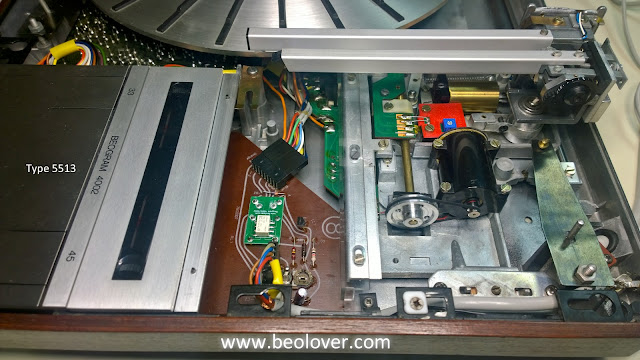This Beogram 4002 unit has a defect in one of the cartridge connector contacts. I don't know if the defect came that way from the factory or deteriorated with use. The owner has had some problems with cartridge mounting so we felt it warrants changing out the connector on this one.
It is unusual to replace the cartridge mount in the Beogram 4002. It is the Beogram 4000 that quite often has broken (or near broken) cartridge mounts that require a replacement. In any case we hate to steal a working cartridge mount from another Beogram because that still means a Beogram is left without a working tonearm. So having a replacement part such as the Beolover connector is a wonderful solution.
I begin the procedure on the right side of the Beogram so I can loosen the two mounting screws for the tonearm.
There is a small board in the tonearm that transfers the phono signal from the very thin wire in the tonearm base to the color coded wire that travels down to the cartridge connector. This allows the tonearm to be de-soldered and removed at small board and we can use the color coding to put things back correctly.
I un-solder the red and white wires from the top of the board with the tonearm in its normal position.
Then I flip the tangential arm assembly over to get to the underside of the board for the blue, green and gray wires. The tangential arm assembly rails and drive screw have to be removed to allow this maneuver. It is worth it though as you don't want to make a mistake here.
With the tonearm completely removed I dip the end with the connector into some boiling water for a minute then into ice water. A push on the connector through the back end of the tonearm should break the connector loose so it can be removed.
This one came out on the first attempt. Sometimes it takes more.
If you have to re-use the tonearm wires then take care in this operation. I always like to install new wires that are a little smaller (36 gauge).
Here is the original cartridge connector removed and opened up. It comes in two halves (an upper and lower). This repair keeps the lower half and replaces the upper part of the connector.
As you can see in the pictures, the red highlighted areas show this connector has a broken or worn area of one of the contacts (left channel low signal).
Here is the Beolover replacement part for the upper section of the connector. I tinned the four contacts in preparation for the new phono wires.
I replaced all five original wires in the tonearm with the same color 36 gauge wire except for the ground wire which I changed from gray to black (just a personal preference).
To keep the wires down in the channel before gluing the connector halves together I use some Aleene's Tacky Glue. It is a handy glue that is removable if necessary. I don't want permanent epoxy here.
Once the glue is dry I put the wires right at the connector end into a small bundle so it will be easier to remove this connector again in the future. When I glue the two connector halves back together I use Aleene's glue again for that and I attach a cartridge so I make sure I have the connector pieces aligned properly.
When I re-insert the connector and wires back into the tonearm tube I place a little more Aleene's glue on the sides of the tube (on the inside). That way no glue will get on the end of the connector or the cartridge.
The above photo shows the cartridge removed but when I inserted the connector for real I always have a cartridge attached to insure a proper installation of the connector.
The cutting, stripping, tinning and soldering of wires onto the transfer board takes some patience. I did the red and white wires on the top first again, then flipped the transport over for the remaining three.
The transport is then flipped back over to its proper position and the tonearm is carefully re-attached.
You have to be very gentle tucking the phono wires back into the tube as you re-install the tonearm to the tonearm mounting hardware.
After the tangential arm assembly is put back together I did have to recheck the following alignment adjustments: the stylus tracking path, the tracking force weight and the tangential arm tracking sensor operation.
Back to an audio system for record play testing... both channels play beautifully through the new cartridge connector.



















No comments:
Post a Comment
Comments and suggestions are welcome!